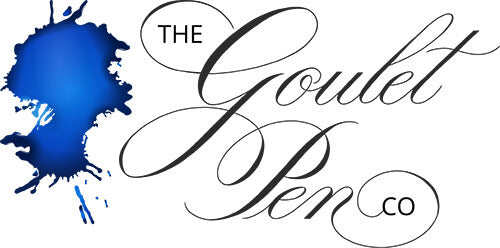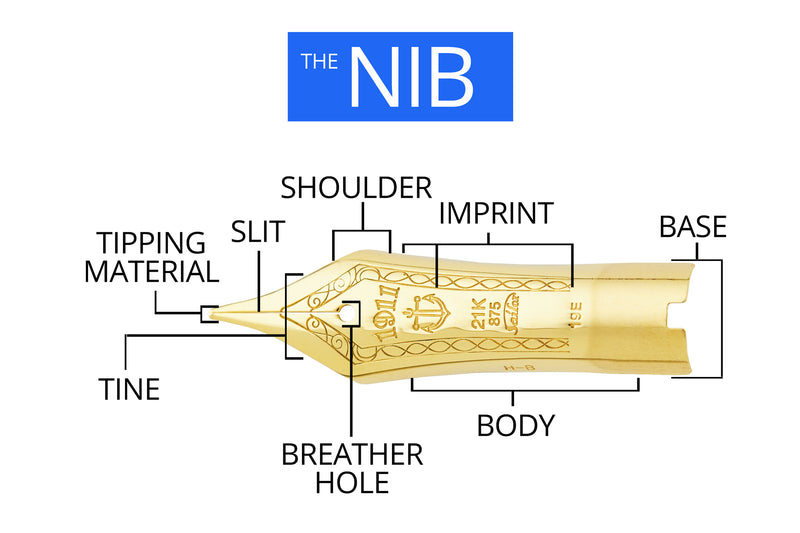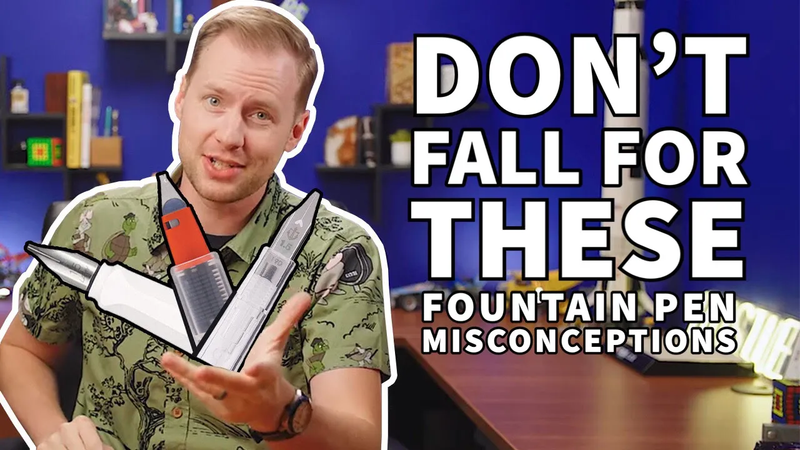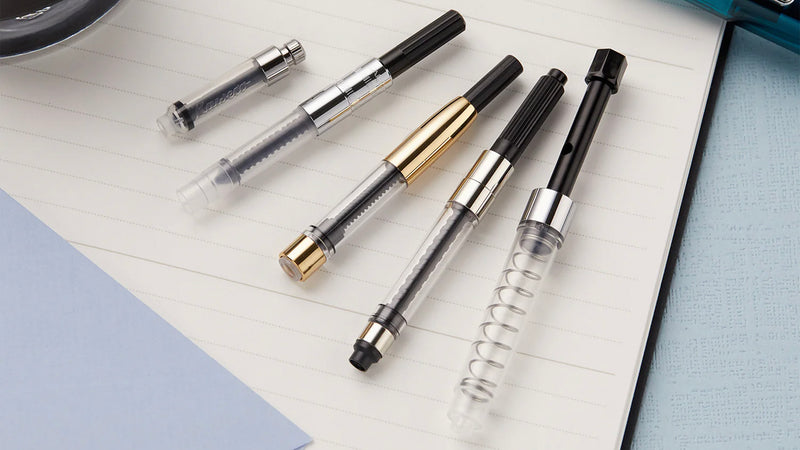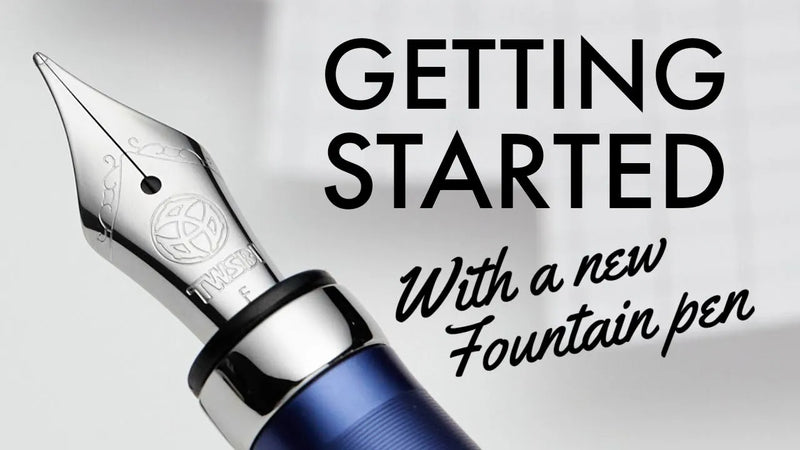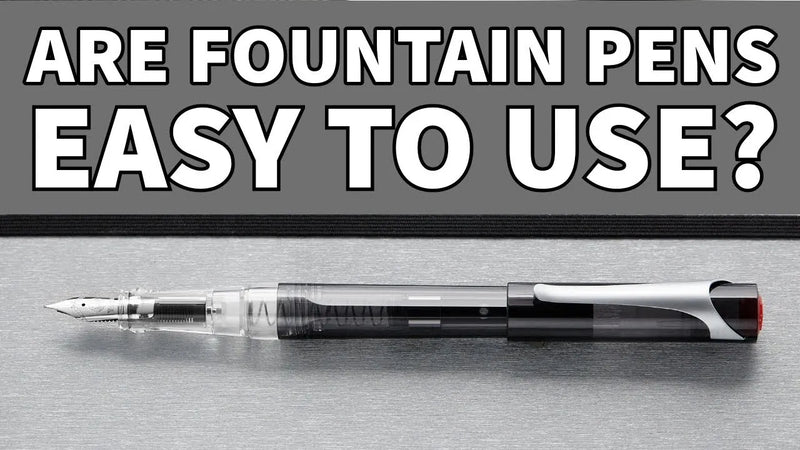Glossary of Fountain Pen Terminology
Click on a letter to skip down to that section:
A B C D E F G H I J K L M N O P Q R S T U V W X Y Z
Acrylic (aka Resin) - A common material used for making fountain pens due to durability, light weight, ink/water resistance, and resistance of staining. It's basically plastic.
Aerometric - A type of filling mechanism that uses a bladder (or sac) inside a metal cartridge; you fill by squeezing the sac. More common in vintage pens.
Air Channels - The slits cut in the feed that allow air to help draw ink through the feed.
Archival - Fountain pen ink that is fade-resistant, retaining much of its original look.
Baby's Bottom - When the tip of a nib is too rounded where the two tines meet, preventing the capillary action needed for the ink to draw down to the paper. Though very smooth writing, nibs with this symptom will typically have skipping problems.
Balance - Refers to how evenly distributed the weight of the pen feels from the front and back in the hand, and it varies based on the person holding it. It can either feel evenly balanced, front (nib) heavy, or back (top) heavy.
Ballpoint - A pen with a grease or paste ink that is used by rolling the tip (with a ball) across the paper, which rotates the ball and pulls ink from the pen.
Band (Centerband) - The metal decorative ring that is usually placed near the bottom of the pen cap for decorative purposes, or to provide reinforcement to the cap threads.
Barrel - The long part of the main body of the pen which houses the ink reservoir. Usually threads onto the grip section, but in certain pen models such as a vacuum filler, it does not.
Biocide - Chemicals used in fountain pen ink to prevent mold and other biological growths from, well, growing.
Bladder (Sac) - The rubbery sac that houses ink in various pen filling mechanisms, such as the aerometric.
Bleeding or Bleedthrough - A symptom of ink soaking through the paper so much that it crosses over to the other side of the page. This can vary based on the ink or the paper but is usually a symptom of paper that is too absorbent. It is more extreme than show-through or ghosting.
Blind Cap - A removable cap that covers a pen's filling mechanism.
Blotter - Usually made of wood or metal, this holds blotting paper that is used to soak up excess ink on a page to decrease drying time.
Blotting Paper - Special super-absorbent paper (like J. Herbin's) that is used to soak up extra ink on the page without smearing it, to decrease dry time when needed.
Body - The main part of the pen (the part without the cap), usually also called the barrel.
Blue-Black - A common designation for a dark blue ink, though there really isn't any strict way to declare a blue-black apart from an ink that is just dark blue, navy, or midnight. The original term comes from iron gall or similar inks where the ink begins as a blue color, and over time fades into a dull black color.
Brassing - When a plating wears off, exposing the underlying metal (usually brass).
Breather Hole - A hole in the nib, at the end of the nib slit, that allows air to assist in the ink flow, also called a vent hole.
Breather Tube - A small tube that is used to assist in filling certain types of pens, such as the Noodler's Ahab Flex Pen.
Bulb Filler - A simple type of filling mechanism that uses a small rubber sac at the end of a large reservoir, and fills by squeezing the sac.
Bulb Syringe - A handy tool used to either suction boogies from your baby's nose or to help flush out cartridge/converter fountain pens while cleaning
Bulletproof - A Noodler's term used to describe ink that is particularly fraud resistant and can withstand water, UV rays, bleach, oven cleaners, etc.
Burping - A symptom (particularly with eyedropper filled pens) where ink comes out in a large drip or blob out of the grip section of the pen. This is usually caused by a variance in pressure between the inside of the pen and the surrounding environment, such as on an airplane with changing pressure or with a pen that has a large reservoir that is low on ink (mostly air) where the heat from your hand while writing can increase the pressure in the pen.
Button Filler - A filling mechanism that works by pushing a button, more common in vintage pens.
Calligraphy - Fancy writing, often done with dip pens but can be emulated with italic nibs.
Calligraphy Pens - A term almost always used to describe italic nib fountain pens, usually in the lower price range and sold in sets to lure writers in who want to make their handwriting appear like calligraphy. True calligraphy pens are typically dip pens, which do not use a feed like fountain pens.
Cap - The part of a pen that covers the nib and attaches to the pen body.
Capillary Action - The ability of a liquid to flow in narrow spaces without the external forces like gravity. This is the basis for how a fountain pen works.
Cartridge - A small, sealed plastic reservoir that holds fountain pen ink. Many pen brands use their own proprietary style, but there is one common style called Standard International, where many pen makers use the same type of cartridge. The benefit of cartridges is the convenience, however, they are not nearly as economical as bottled pen ink and the color range is usually incredibly limited
Cartridge/Converter (C/C) - A small filling mechanism (usually a screw-piston type) that fits onto a pen that also accepts a cartridge. This allows you to use any brand's bottled ink instead of relying on limited proprietary ink cartridges.
Clip - The metal doohickey usually attached to the cap that holds your pen in your shirt pocket and also keeps it from rolling off your desk and landing nib first on the ground (why does it ALWAYS fall nib down??).
Conversion - When you are altering a pen in some way to provide an alternate filling method. The most common practice is using a 'cartridge converter' to use bottled ink in a pen in place of ink cartridges, or in filling the whole body of a pen with ink (this is the eyedropper method).
Converter - A cartridge-shaped reservoir that allows you to use bottled pen ink when a cartridge would otherwise be your only option. Pens that have this option are usually referred to as cartridge/converter or C/C.
Corrosion - When the metal parts of your pen either rust or chemically disintegrate due to chemical exposure or oxidation.
Crack - When your pen material (usually plastic) splits apart. This is usually caused by stress in some way, either due to extreme force (like dropping your pen on a hard surface) or over-tightening of certain parts.
Crisp (Italic) - A nib ground so that the tip is flat, with very sharp edges to give a very distinct line variation from cross-stroke to downstroke. These nibs require you to write slowly and hold the pen at a very specific angle, otherwise, the sharp edges of the nib will tear the paper.
Cursive (Italic) - A nib ground so that the tip is flat, but with slightly more rounded edges. This sacrifices a bit of line variation, for the benefit of a smoother and more forgiving writing experience than a crisp italic. This nib is sometimes called a 'stub', though a stub is typically even more rounded than the cursive italic.
Demonstrator - Transparent pens, originally developed for salesmen to show to distributors and retailers to display the inner workings of the pens' parts. Now, it is a common aesthetic design adopted across many brands. The appeal is that you can see the ink level clearly in your pen without having to take it apart.
Dip Pen - A writing instrument that doesn't have an internal ink reservoir, it instead must have its nib immersed in ink every few words to keep it writing. Dip pens typically use ink that is thicker (usually shellac-based) than fountain pen ink.
Dip Test - When you want to get an idea of how a particular color of ink will look in your fountain pen, but you don't want to draw ink all the way up into it (thus meaning you have to do a full cleaning), you instead just immerse the nib into the ink and write with it without ever drawing ink into the pen.
Drawing Ink (India Ink) - Ink that is composed of a fine soot that is combined with water and a binding agent such as shellac. This ink is more durable and permanent than fountain pen ink, but should only be reserved for use with dip pens.
Dry - When ink does not flow very freely or heavily out of a pen. This can be either a characteristic of a pen or an ink, but both are referring to the same end result of a limited amount of ink coming out of the pen.
Ebonite - A hard rubber material commonly used in vintage (and some modern) pens.
Eyedropper - Not specific to any brand, a type of filling method where the entire body of the pen is used as a reservoir for the ink.
Eyedropper Conversion - The process of modifying a fountain pen that has an existing filling mechanism (such as cartridge/converter, piston, or aerometric) so that the entire body of the pen can be used as an ink reservoir.
Feathering - A term used to describe when fountain pen ink soaks into absorbent paper, resulting in a veiny pattern that branches out from the line drawn. It can also be referred to as 'spread'.
Feed - The piece of plastic or ebonite (usually black) that hugs the back of the nib and acts as a vehicle for ink delivery from the reservoir to the nib.
Feedback - The amount of 'bite' or resistance perceived during a writing experience. This is a consequence of the relationship between the smoothness of a fountain pen nib and the smoothness of the paper being used. Also commonly referred to as 'tooth'.
Feed Channel - A very thin slit in the feed that hugs against the back of the nib and provides a route for the ink to travel through the feed. This is what helps to provide the necessary capillary action required for ink flow.
Filigree - a decorative (usually precious) metal overlay with openings that show the material of the pen under it.
Flex - The ability of the tines of a fountain pen nib to spread under varying writing pressure, resulting in variation of the width of the line drawn. It's super cool.
Flooding - Forcing ink down through the feed by intentionally pushing it out of the reservoir.
Flow - The movement of ink through the pen. Often described as 'wet' or 'dry', depending on how freely the ink is willing to come out of the pen.
Fluorescent - The ability to glow under UV/blacklight.
Freeze Resistant - Ink that is formulated to resist freezing at extremely low temperatures.
French-Ruled Paper (Séyès) - Standard 'school' paper in France, it is an 8mm x 8mm grid that is separated by 2mm horizontal lines to give guidance and structure to cursive writing.
Gel Pen - A disposable cartridge-type pen that has a gel-based ink inside it (such as Pilot G2).
Ghosting - When you can see what's written on the other side of a sheet of paper without the ink coming through the page. This isn't to be confused with bleed through, where the ink actually soaks through to the other side. This is also known as show-through or echo.
Glass Pen - A glass writing instrument that must be dipped in ink, which delivers ink to the paper through a series of twisted flutes on the tip.
Gold - You know what this is. Typically used for nibs on more expensive pens or as plating for decoration on fountain pen hardware.
GSM - (aka 'g' or gm^2) grams per square meter, a measurement of a paper's weight. Though this designation is commonly used to refer to a paper's thickness, not all papers with the same GSM may be the same thickness, because there are other factors involved such as the material of the paper and the sizing used that influence how heavy it is. Generally speaking though, it is best to use papers that are 80g weight or higher for good performance with fountain pens (though there are of course always exceptions).
Grip section - The part of the pen you hold where the nib fits in, sometimes called just a 'section'.
Halo - An ink property where there is an intentional separation of dye components to give a highlighting effect. It may look like feathering in a different color.
Hardware - The metal ornamentation on a pen, usually referring to the clip, finial, and center band. Also called 'trim'.
Highlighter - Fountain pen inks that are designed to be used to highlight on top of written or printed ink.
Hooded Nib - A nib with a covering that goes over the top of it, making it less likely that you will touch it and get ink on your fingers. Made famous by the Parker 51.
India Ink - Ink that is composed of a fine soot that is combined with water and a binding agent such as shellac. This ink is more durable and permanent than fountain pen ink, but should only be reserved for use with dip pens.
Ink - The liquid substance that you put in a fountain pen to be able to use it for more than a paperweight or a piece of jewelry.
Ink Syringe - A hypodermic needle (ideally blunt-tip) that is used to refill ink cartridges or decant the last bit of ink from a bottle.
Ink Window - a translucent section of a pen that allows you to see when your ink level is getting low.
Inkwell - A storage container used for housing liquid ink, usually made of glass.
Insert - A cone-shaped reservoir that seats inside a bottle of ink to help you fill a fountain pen when the ink level gets low.
Invisible - Fountain pen ink that is clear and is nearly invisible on paper to the naked eye when written with. These inks can be viewed later using other means, like specific lighting conditions.
Iridium - A very hard-wearing metal (usually some kind of alloy) used for tipping material on fountain pen nibs.
Iridium Point Germany (IPG) - A designation displayed on some manufacturer's nibs. Iridium refers to the hard-wearing metal used to create the ball on the tip of the nib, and the German aspect could mean a variety of things. It doesn't necessarily mean the nib was made in Germany, but just that (at least) the tipping material used for the point comes from Germany. This is quite confusing and does create some mystery about where some nibs actually come from. Brian Gray of the Edison Pen Company has a great article on the IPG Nib designation.
Iron Gall (Ferrogallic) - Ink made from iron salts and tannic acids. Though quite permanent and waterproof, these inks are typically known for causing chemical corrosion to metal pen parts (especially the nib) and should be used sparingly or with less-valuable pens. Modern iron gall formulations are not as harmful as the inks of the past, but extra precaution such as not leaving the ink in a pen for more than a week is strongly recommended.
Italic (Nib) - A type of grind where the tip of the nib is flattened so that there is a distinct line variation while you write when you change from the cross-stroke to the down-stroke.
Lacquer - Clear or colored varnish that's used to provide protection and durability to a pen's surface.
Limited Edition (LE) - Pens that are designed to be made in only limited numbers. They are often engraved with a designation with which number pen it is.
Lubricated - Ink that has special additives to make it flow better in your pen, and keep the internal components operating smoothly. Noodler's American Eel series of inks are most known for this property.
Maki-e - Japanese lacquer sprinkled with precious metal powder as a decoration. There are several different methods of this technique, but all of them are extremely cool, very hard to do, and take forever to do, which makes pens with maki-e very expensive.
Mixable - Fountain pen inks that are designed to be mixed together to create new colors without adverse reactions between inks.
Mold - Spore growth in ink, also referred to as SITB (Stuff In The Bottle). Mold is a 'four-letter-word' in the fountain pen ink world, and generally very frowned upon. It can either come up as white fuzzy stuff on the surface of the ink where you can see it as soon as you open a bottle or as sludge down inside the ink that is much harder to find until you suck it up into your pen. Though mold is quite scary, it seldom actually causes any long-term damage to a pen. Most ink companies put biocides in their inks to prevent the growth of mold, so it is rare that it occurs.
Music Nib - A type of stub/italic nib that is designed for increased ink flow. Platinum and Sailor both have nibs they call Music Nibs, and they are really little more than regular stub nibs. Traditionally these nibs have three tines (two slits) and were originally designed for easy music notation.
Nail - Nibs that have no flexibility at all, that write as stiff as a....nail.
Newbie (Noob) - Someone brand new to the world of fountain pens.
Nib - The metal tip of a fountain pen that actually touches the paper.
Nib Creep - When ink comes up through the nib tines and covers part of the top of the nib. It can be a symptom of the ink or pen, but is purely aesthetic and doesn't typically have any effect on the function of a pen.
NID - New Ink Day, when your new ink shipment arrives.
NPD - New Pen Day, when your new fountain pen arrives.
Oblique - A nib grind that is like an italic, but slanted to one side (either left or right). This grind is quite rare these days and is hard to find unless you have it custom ground.
O-Ring - A rubber ring that helps to seal internal components of a pen from leaking ink.
Overwriter - Someone who writes with their hand on the page so that it sits above where the nib is writing. This term is most commonly used to describe left-handed writers, as it creates a special problem due to the fact that the hand would be rubbing directly over what's being written.
Palladium - A durable silvery-white precious metal in the platinum family used by some pen manufacturers in their pens.
Permanent - Traditionally, a fountain pen ink that is water resistant and fade resistant. In more rare cases, permanent ink can even be acid proof, UV resistant, forgery-resistant and more.
Pigmented - Fountain pen ink that is made up of finely-ground solid particles in liquid suspension, like paint. Some brands make specially-formulated pigmented ink for use in fountain pens, where the solid matter is microscopically ground to the point where it can flow through feeds.
Piston - A type of mechanism that uses a retracting plunger inside a sealed tube in fountain pens and converters to draw ink into a pen. They can either be screw or push operated, though screw pistons are the most common.
Piston Filler - A fountain pen that has a piston filling mechanism built into the body of it, so that the body of the pen acts as the ink reservoir.
Plating - When a thin coating of one metal goes overtop of another, usually to provide added wear protection and aesthetic appeal. Common examples are gold-plated steel or rhodium-plated gold.
Plunger - The rod inside a piston that moves up and down to draw ink in and out of a pen (or converter).
Posting - When you put the cap of a pen onto the back end of the barrel (the part you hold).
Prime - When you soak a pen feed with ink to get it started. This happens as a consequence of filling a pen through its nib when filling from a bottle of ink, but you can also prime a pen by forcing ink down through the feed by reversing the filling mechanism from the way you filled it.
Proprietary - Refers to components that are designed and made to fit specifically one brand, as opposed to being universal. Examples would include LAMY nibs fitting only on LAMY pens, or Pilot ink cartridges fitting only on Pilot pens.
Railroading - When the flow of ink is broken and the result is that the tines of the nib draw two separate, parallel lines on the page. This is most common using flexible nib pens.
Reservoir - A cavity inside a pen that holds ink.
Resin - Plastic. There are different types of resins (ie PMMA, cellulose acetate, etc) but all fall under the plastic bucket.
Retractable Nib - A pen that is designed without a cap, so that the nib itself draws into the pen body when closed. The most popular pens that do this are the Pilot Vanishing Point and Lamy Dialog 3. This is a common feature of ballpoint (click) pens, but not common in fountain pens.
Rhodium - An extremely durable (and expensive) silver-colored metal most often used for plating over stainless steel to provide added durability to pen hardware and nibs.
Rocker Blotter - A tool (usually wood) that holds sheets of specially absorbent blotting paper that is used to soak up excess ink left on paper.
Rollerball - A pen that contains a gel ink that is housed inside a replaceable cartridge.
Sac - a rubbery reservoir that houses ink. Common in many vintage pens, they're used much less often today.
Saturation - An ink term used to describe the perceived intensity of a specific color. Ink users often refer to the level of saturation of an ink by how much dye is perceived to be present in the ink. Generally speaking, the higher saturated inks have bolder colors but extended drying times on paper.
Scented - Fountain pen ink that is formulated to have a specific smell, generally corresponding with the ink name.
Scratchy - When a nib provides resistance when being moved across the paper, often caused by misaligned nib tines.
Screw Cap - A pen cap that is removed/replaced by interlocking threads on the cap and pen body that mate together with a twisting motion.
Section - The part of the pen you hold where the nib fits in, often called a 'grip section'.
Semi-Flex - When a nib bends slightly under pressure to give a soft feel when writing, not to the extreme of flex nibs where the nib tines actually separate to provide line variation.
Séyès (French-Ruled) Paper - Standard 'school' paper in France, it is an 8mm x 8mm grid that is separated by 2mm horizontal lines to give guidance and structure to cursive writing.
Shading - A common (and often desired) result of a fountain pen ink pooling in certain parts of a letter when writing, so that the color and saturation of the ink appears different within a single letter or word. This characteristic cannot be achieved with ballpoint or rollerball pens and is a very appealing aspect of fountain pen use for those particularly drawn to all the pretty ink colors.
Sheen - Characteristic of a fountain pen ink where when ink pools another color can be seen on top of the ink, especially when looked at in different light angles using certain paper types.
Shimmering - Fountain pen ink that has small particles of glitter mixed in.
Show-Through - When you can see what's written on the other side of a sheet of paper without the ink coming through the page. This isn't to be confused with bleed through, where the ink actually soaks through to the other side. This is also known as ghosting or echo.
Silicone Grease - A clear, inert grease that is used to lubricate moving parts of fountain pens, as well as seal up threads for eyedropper conversions. The appeal of this grease is that it doesn't harden over time, it is water/ink-resistant, and it will not react with fountain pen inks.
SITB - "Stuff In The Bottle", a term used to describe mold, sludge, chemical sedimentation, or some other 'strange' foreign substance present in a bottle of pen ink.
Sizing - A coating for paper that affects its ability to absorb liquids (like ink). Heavily sized papers are typically more ideal for fountain pens because they are smoother and more ink repellant.
Skipping - When ink doesn't flow consistently from a pen, causing the ink to start and stop flowing as you write. This could be caused by the pen, paper, ink, or any combination of the three.
Slit - The very thin cut running from the tip of the nib up to the breather hole that carries the ink from the feed to the tip of the nib.
Snap Cap - A pen cap that is removed/replaced by pulling/pushing onto the pen body, usually resulting in a clicking sound.
Soft - A term used to describe a nib that is springy and somewhat flexible.
Special Edition (SE) - Similar to a limited edition, but typically without individual serial numbers. A product produced for a limited period of time.
Stainless Steel - A very common alloy used in the making of fountain pen parts, particularly nibs.
Standard International - The most commonly accepted size of fountain pen ink cartridges and converters that many manufacturers use. Many pen companies use all proprietary parts for their pens, but the only real 'common' standard for ink cartridge and converters that crosses into multiple brands is the Standard International. There are both short cartridges (most common) and long cartridges that are considered Standard International size.
Stub - A nib that is ground so that the tip is slightly wider than it is tall, resulting in a variation in line width when switching between writing on the cross-stroke and down-stroke. This is similar to an italic nib, but with more rounded edges to make writing smoother and more enjoyable for everyday use.
Syringe - A tool used to refill ink cartridges, get last bits of ink out of a bottle, clean pen parts, and fill certain pens such as eyedropper pens.
Taper - When the diameter of a pen part gradually gets smaller.
Threads - Thin grooves cut into a pen to hold parts together, especially pen caps to the pen body.
Tip - The small ball part on the end of a fountain pen nib that actually touches the paper when writing.
Tipping Material - A small bit of hard-wearing metal (usually some sort of iridium alloy) that is welded to the end of a nib and ground to a specific intended size.
Tooth - The amount of 'bite' or resistance perceived during a writing experience. This is a consequence of the relationship between the smoothness of a fountain pen nib and the smoothness of the paper being used. Also commonly referred to as 'feedback'.
Translucent - When a pen material is not entirely opaque, and you can see light coming through it. This comes in handy with fountain pens when you want to be able to see your ink level at a glance.
Trim - The metal ornamentation on a pen, usually referring to the clip, finial, and center band. Also called 'hardware'.
Two-Tone - When two different metals are used next to each other, often on a fountain pen nib. Often it is yellow gold and rhodium.
Urushi - An extremely durable and beautiful Japanese lacquer derived from Urushi trees. The urushi lacquer process is very skill and time intensive, and quite hazardous when wet since it contains urushiol, the active ingredient in poison ivy. When cured, it creates an incredibly hard and durable finish for pens and can be polished to a very high sheen.
UV - Ultra-violet, radiation that affects ink colors in particular to cause fading.
Vacuum-Fill - A design of pen that uses a combination of pressure and vacuum to create suction to fill a fountain pen with ink.
Vegetal - A type of resin that's used for making fountain pens, most notably Noodler's brand. It has a very distinct smell when manufactured, though it does weaken over time. It is also fully biodegradable when buried underground.
Vent Hole - A hole in the nib, at the end of the nib slit, that allows air to assist in the ink flow, also called a breather hole.
Water Resistance - Very rarely is an ink ever "waterproof" and is completely unaffected by water. More often than not, water resistant inks are just that: resistant in some ways to the fading effects brought on by exposure to water. Water resistance means that a portion of the ink will remain after being subjected to water. This might only be one ingredient of the ink, leaving behind a legible remnant with little or no representation of the original color.
Wet - When ink flows very freely and heavily out of a pen. This can be either a characteristic of a pen or an ink, but both are referring to the same end result of a generous amount of ink coming out of the pen.
Wet Noodle - A flexible nib pen that is incredibly flexible with even the slightest of pressure. These pens were more common around the turn of the 20th century, and are now coveted in the vintage pen market and sold at an absolute premium.
